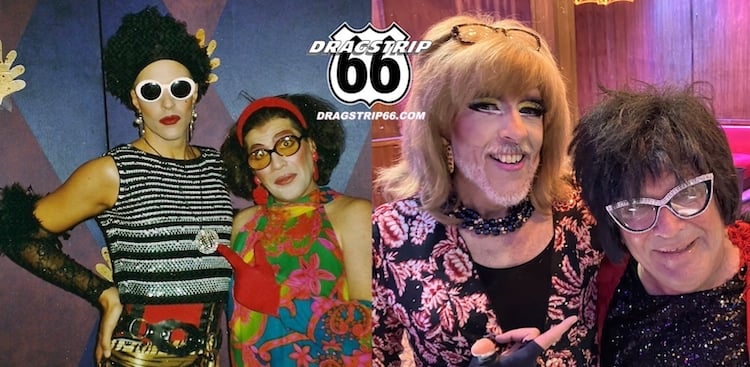Dragstrip 66 was a phenomenon in Los Angeles’ queer community — A beloved monthly event for the alternative gay nightlife scene.
DJs spun rock ‘n’ roll and underground music for the dance floor and lip syncing was not allowed in their stage shows. Drag queens sung live parodies of pop music.
During its 20-year run, 1993-2013, Dragstrip 66 existed at various Silver Lake-area venues: Rudolpho’s, The Echo, Echoplex, Safari Sam’s.
The drag aesthetic was punk, “messy,” and “gender fuck inspired.”
“It wasn’t for the faint of heart,” says DJ Paul V. (aka Paul Vitagliano) who cocreated Dragstrip 66 with MC Gina Lotriman (aka Dan Derkacz).
“By virtue of our crowd, it was messy. We weren’t looking for glamour,” he says. “There is no wrong drag, just throw it in a blender. That was the message we sent.
“We wanted the audience to dress up,” he says. “Our central idea was that the patrons come dressed in drag and become a part of the show themselves.”

DJ Paul V. (aka Paul Vitagliano) cocreated Dragstrip 66 with MC Gina Lotriman (aka Dan Derkacz) in 1993. Vitagliano and Derkacz appear in photos taken in 1993 and 2023. Vitagliano is on the left, and Derkacz is on the right in both photos. Photos: Provided by Paul Vitagliano
Vitagliano and Derkacz organized a 30th anniversary reunion for Dragstrip 66 at Los Globos and sold all 700 tickets in April.
On Sunday, they are at it again. This time, Dragstrip 66 will host its first Sunday tea dance, “Beach Bondage Barbie,” that will start at 4 p.m. It will take place at Los Globos.
Clicking this special click provides half-price discount tickets.
Vitagliano has plans for up to four Dragstrip 66 parties a year.
The name Dragstrip 66 is a nod to the “Sunset Strip” and Route 66, where their first location, Rudolpho’s, was located.
In an interview with Q Voice News, Vitagliano, 61, talks about no lip synching at Dragstrip 66, how the monthly party was an escape from the sadness and trauma of the AIDS epidemic, and why he wants Gen Z queer people to attend the events.
Here are some excerpts.
Dragstrip 66 a safe space for authentic expression
“That’s why we always said, Whatever that is for you is perfect. There’s no right or wrong in how you present yourself,” Vitagliano says.
“That gave a lot of people the opportunities to really explore who they were, whether it was their own sexuality, their gender expression,” he says.
“It was a safe welcoming space for that because we knew there were closeted kids or closeted people who showed up,” he says. “During the day, they probably had a job where they couldn’t come out. Dragstrip gave them that release too.”
‘Beach Bondage Barbie’
“It’s a mashup,” Vitagliano says. “We have three themes: the beach; leather, bondage, S&M, and Barbie is the zeitgeist of the moment.
“Barbie had lots of looks. I’m sure we will have a ‘Walk of Shame’ barbie if all things go correctly,” he said, chuckling.
Vitagliano and DJ Tommy Rocker will rotate sets spinning all kinds of fun, eclectic, and unpredictable dance music from the 60s to today. The 6 p.m. drag show features Gina, Miss Barbie-Q, Love Connie, Bitzi Bobs, and The Cocks.
“We also have a surprise 7 p.m. mystery performer, but our lips are sealed on who it is,” Vitagliano says.
Standing on shoulders
“We want the young queer community to come to Dragstrip 66 and see that they’re standing on our shoulders,” Vitagliano says. “We’re part of the reason why they can walk down the street and hold hands and kiss each other in public.
“And we stand on the shoulders of John Waters, and San Francisco’s The Cockettes, Sylvester, and all the other queer people in the 50s and 60s and the 70s who paved the way for us to be Dragstrip.”
No lip syncing at Dragstrip 66
“Before we started in 1993, many of the drag queens were doing Judy Garland, Bette Midler, Liza Minneli,” Vitagliano says. “We didn’t find it interesting to watch something move their mouth to someone else’s song.
“We wanted to cultivate personas. We pushed back against the lip synching,” he says. “We didn’t want perfection.”
Launched during the AIDS epidemic in 1993
“We were very inspired by ACT UP. They inspired us to care,” Vitagliano says. “Because so many of our friends had AIDS, we all needed to be in the same lifeboat together.
“Things were very sad during the day. That’s when we were sort of dealing with some very rough and hard things,” he says.
“At Dragstrip, you could let go of that. There were some people that had AIDS themselves who could come there for a few hours and forget about that and just be a regular person with their friends having a good time. Even for just a few hours a month, you could feel free,” he says. “It was an escape.”
30th anniversary show happened in April
“Dan was on the same page. He was like, We obviously still have more to say, and more to do, because of what has been happening politically, and the targeting of our community again,” Vitagliano says.
“We left on this upward trajectory and evolution as a human race. Now we’re at the point where they’re literally showing up at our events with guns. And if they could kill us all they would. That’s the cold hard truth of it,” he says.
“So our community needs to love even harder and vote even stronger.”
